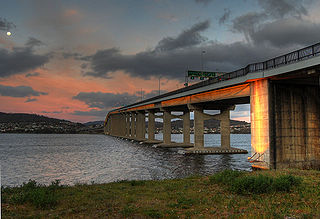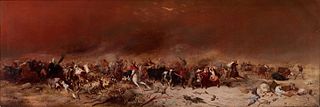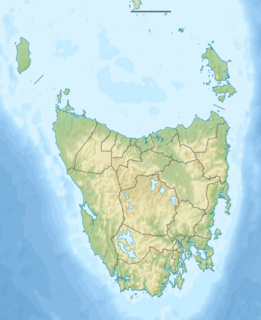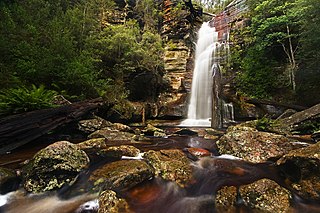
The River Derwent is a river located in Tasmania, Australia. It is also known by the palawa kani name timtumili minanya. The river rises in the state's Central Highlands at Lake St Clair, and descends more than 700 metres (2,300 ft) over a distance of more than 200 kilometres (120 mi), flowing through Hobart, the state's capital city, before emptying into Storm Bay and flowing into the Tasman Sea. The banks of the Derwent were once covered by forests and occupied by Tasmanian Aborigines. European settlers farmed the area and during the 20th century many dams were built on its tributaries for the generation of hydro-electricity.

The Tasman Bridge is a five-lane road bridge that carries the Tasman Highway (A3) across the Derwent River and the Southern rail line, located near the central business district of Hobart, Tasmania, Australia. Including approaches, the bridge has a total length of 1,396 metres (4,580 ft) and it provides the main traffic route from the CBD to the eastern shore. The bridge has a separated pedestrian footway on each side. There is no dedicated lane for bicycles; however, steps to the pedestrian footway were replaced with ramps in 2010.

The history of Tasmania begins at the end of the most recent ice age when it is believed that the island was joined to the Australian mainland. Little is known of the human history of the island until the British colonisation in the 19th century.

Rosebery is a town on the west coast of Tasmania, Australia. It is at the northern end of the West Coast Range, in the shadow of Mount Black and adjacent to the Pieman River now Lake Pieman.
Donald Henry Tuck was a bibliographer of science fiction, fantasy and weird fiction. His works were "among the most extensive produced since the pioneering work of Everett F. Bleiler."

Mount Read is a mountain located in the West Coast region of Tasmania, Australia, and is at the north west edge of the West Coast Range.
The mines of the West Coast of Tasmania have a rich historical heritage as well as an important mineralogical value in containing or having had found, specimens of rare and unusual minerals. Also, the various mining fields have important roles in the understanding of the mineralization of the Mount Read Volcanics, and the occurrence of economic minerals.

Risdon is a suburb of Hobart, capital city of Tasmania. It is west of Risdon Vale.
The Mount Read Volcanics is a Cambrian volcanic belt that exists in Western Tasmania.

SS Lake Illawarra was a handysize bulk carrier of 7,274 tons in the service of the Australian National Line shipping company. This ship is known for causing the Tasman Bridge disaster when she collided with pylon 19 of Hobart's giant high concrete arch style Tasman Bridge on the evening of 5 January 1975 at 9.27 pm, resulting in the deaths of 12 people.

Lutana is a suburb of Hobart, Tasmania, Australia. It is part of the City of Glenorchy.

Prince of Wales Bay is located on the western shore of the River Derwent in southern Tasmania, Australia.

Zinifex was an Australian company that operated lead and zinc mines, refineries and a lead smelter. It was established in April 2004, when the assets of Pasminco were spun-off. In 2008 it merged with Oxiana to form OZ Minerals.
Cockle Creek Smelter was a zinc and lead smelter located at the northern end of Lake Macquarie near Boolaroo in Newcastle, New South Wales. The smelter was built in by the Sulphide Corporation in 1896 and the first attempts to refine zinc using the Ashcroft Process began in 1897 but that process was abandoned shortly after due to technical difficulties.

Snug is a small coastal town on the Channel Highway located 30 kilometres (19 mi) south of Hobart in Tasmania, Australia. At the 2006 census, Snug had a population of 881. Snug is a part of the Municipality of Kingborough.
The Emu Bay Railway was an Australian railway company. Listed on the Melbourne Stock Exchange, it operated the Melba Line on the West Coast of Tasmania from 1897 until 1998.
Lou Rae is a Tasmanian author and historian of the West Coast of Tasmania.
Ernest Edgar Kurth, also known as E. E. Kurth, is best known for his work at the University of Tasmania with investigations into the chemical constitution and properties of Tasmanian and New South Wales oil shales, for which he was awarded the degree of Doctor of Science in 1934. During WWII he gave special attention to the pyrolysis of timber and its trace elements. He was author of several papers on the subject and held a patent for improvements to charcoal kilns.
Sir Herbert William Gepp was an Australian industrial chemist, businessman and public servant.
Sir Colin Fraser was a mining engineer and executive in New Zealand and Australia